|
|
 |
|
March
20, 2000
The
Incredible Gerta Ries Wiener
by Mel Wacks
A tribute
to a wonderful artist, a unique person, and a good friend who
died in her sleep on March 1, 2000 at the age of 101.
Copyright
story reprinted by permission from the Sept. 14, 1998 issue of
Coin World.
I first
encountered Gerta Ries Wiener when I received a call from Medallic
Art Company about 30 years ago. Medallic Art Company was then
located in Manhattan, and had struck the first two medals in the
Magnes Museum's young Jewish-American Hall of Fame series, which
I had initiated in 1969.

Gerta Ries Wiener and Mel Wacks at the Jewish-American
Hall of Fame exhibit at the Magnes Museum.
The representative
informed me that someone had walked in with a plaster model for
a medal. He put the "mystery" medallist on the phone, and I found
out that Gerta Ries Wiener had been asked by her brother to create
a portrait medal for Supreme Court Justice Louis Brandeis. Aha!
That was a clue, since I had asked Victor Ries - who had created
the very first medal in our series, honoring Rabbi Judah L. Magnes,
as well as the unique rounded trapezoidal shape of our medals
- to design a Brandeis medal for us. What I subsequently learned,
is that Victor did not do portraits, and had passed the assignment
along to his sister.
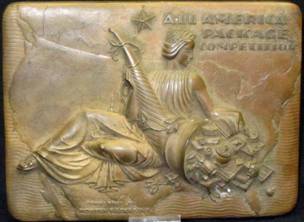
A young Gerta Ries had sculpted this award plaque for the "All American Package Competition/ Sponsored by Modern Packaging.”
Evidently,
Gerta was told that by Medallic Art Co. that her first effort
was not suitable, and so she redid it. I regret that I never saw
her original work, but the final portrait - displaying the renowned
jurist's Lincolnesque profile -- was quite good. Gerta, from the
very beginning, took a deep interest in her subjects, reading
and researching extensively. In a letter dated April 1971, she
wrote, "A portrait should be much more than a literal rendition
of features. But having a strong mental image of the man from
what he had been and said, helped me to express some of his personality
through my work." The reverse inscription, "Make real the brotherhood
of man," was sculpted from a design by Victor Ries.
|
|
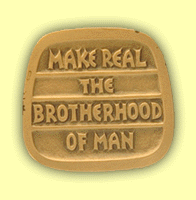
|
| Medal
by Gerta Ries Wiener (1971), Louis Brandeis, Supreme Court
Justice. |
Jacob Marcus,
the "Dean of Jewish-American Historians," wrote that "The Brandeis
medal is beautiful. We are delighted to have it for the (American
Jewish) Archives." And, I should point out (even though she was
angry with me whenever I mentioned her age) that Gerta Ries Wiener
was over 70 when she created this first medal!
It was not
until four years later, that I again commissioned Mrs. Wiener
to do a medal - this time, honoring Gershom Mendes Seixas, American
Revolution patriot. She carefully studied period clothing and
created a realistic portrait as well as a dramatic scene of four
patriots removing ceremonial objects from their synagogue when
the British captured New York. This was the first of many dynamic
group scenes that Gerta would create for the Magnes Museum over
the next three decades.
|
|
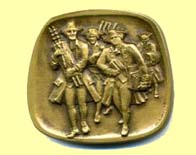
|
| Medal
by Gerta Ries Wiener (1975), Gershom Mendes Seixas, Patriotic
Rabbi. |
Knowing
that I had found a good thing, I immediately commissioned Gerta
to design our next commemorative - the first in our series honoring
a woman. The reverse design is notable in that it features Henrietta
Szold along with 12 children, ranging from babies in diapers to
teenagers -- representing the Youth Aliyah program that gave Holocaust
survivors new homes in Palestine. This loving portrayal of youngsters
on this and subsequent medals for the Magnes Museum reflect Gerta's
close association with children. She illustrated "Dreamland,"
"Dimple Diggers," and other books, gave art classes for emotionally
disturbed children, created puppets and performed marionette shows
at schools.
|
|
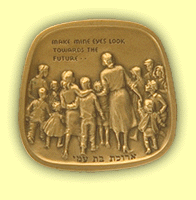
|
| Medal
by Gerta Ries Wiener (1976), Henrietta Szold, Founder of Hadassah. |
Victor Ries
produced his second medal for the Jewish-American Hall of Fame
in 1977 (Touro Synagogue), and then it was Gerta's turn again.
Produced to celebrate Golda Meir's 80th birthday, it also was
issued on the artist's 80th birthday! This was the first medal
in our series honoring a living person. Gerta actually tried to
meet with Golda on a trip to Israel while she was working on the
medal, but unfortunately the former Prime Minister was unavailable.
This medal's reverse featured a group of people - of different
faiths and ethnic backgrounds.
|
|
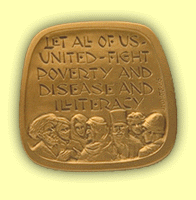
|
| Medal
by Gerta Ries Wiener (1978), Golda Meir, Israel Prime Minister. |
From 1981
through 1983, Gerta created three portrait medals in a row - for
philanthropist and educator Rebecca Gratz, violin virtuoso Isaac
Stern, and "Statue of Liberty" poetess Emma Lazarus. Gerta produced
a lovely portrait of Rebecca, describing it as: "something lighter
and pleasant to look at." For the reverse, Mrs. Wiener "decided
that a simple inscription would be a welcome change after the
crowds of people decorating the reverse of my last 3 medals."
|
|

|
| Medal
by Gerta Ries Wiener (1981), Rebecca Gratz, Philanthropist. |
In spite
of looking at dozens of record covers, Gerta could not find a
suitable portrait of Isaac Stern. She solved that problem by sitting
through several showings of the documentary "From Mao to Mozart:
Isaac Stern in China," going home and drawing the virtuoso's portrait
from memory. Her original version showed Stern in a turtleneck
sweater, that he appeared in for rehearsals. But I wasn't happy.
I told her that he should wear a tuxedo, as he does for his concert
performances. She definitely did not appreciate my comments! However,
Gerta did change Stern's accouterment, and eventually liked the
results. Gerta's neighbor, an amateur violinist, is very proud
of the fact that he posed to show the artist exactly how musical
instrument should be held. The medal's reverse was her first architectural
design -Carnegie Hall's marquee (which has since been replaced).
|
|
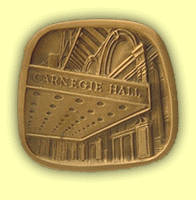
|
| Medal
by Gerta Ries Wiener (1982), Isaac Stern, Violin virtuoso. |
Writing about
the Emma Lazarus medal, Gerta said: "The reverse will please you
with all those people!!" Actually there are 10 figures, including
6 children. The immigrants are standing near the ship's railing,
staring wistfully at the Statue of Liberty in the distance, which
is just "a tiny silhouette."
|
|
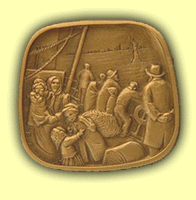
|
| Medal
by Gerta Ries Wiener (1983), Emma Lazarus, Statue of Liberty
poet. |
When Gerta
was a struggling artist in New York in the early 1920s, her husband
encouraged her to create a portrait bust of New York Times' publisher
Adolph Ochs, saying it would make her famous. But she decided
not to pursue the matter. When given a second chance 60 years
later, she did not again pass up the opportunity, saying: "The
picture of Ochs is excellent. His looks certainly have improved
since I saw his big photo hanging in the lobby of the old Times
Building in 1922!" In fact, Gerta produced one of the most lifelike
medallic portraits ever! Knowing my taste for crowd scenes, she
wrote: "I'm sure you'll like it, since ha-ha, it has so many people
on the reverse." (She was right. And the New York Times liked
it too, ordering a large quantity.)
|
|
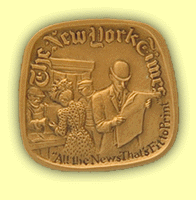
|
| Medal
by Gerta Ries Wiener (1985), Adolph Ochs, New York Times Publisher. |
The Ochs
medal was pictured in the catalog of the 1987 Congress of FIDEM
(International Federation of Medallic art) hosted by the American
Numismatic Association in Colorado Springs. And Mrs. Wiener attended
the conference . at the age of 89!
In 1987,
when Gerta Ries Wiener's Justice Benjamin Cardozo medal appeared,
she said: "He was a hard one to crack, and I do think I captured
his 'hidden' smile!" Even though Gerta had said that she would
not sculpt another architectural design (after Carnegie Hall),
she did a superb job depicting the Supreme Court Building on this
medal's reverse.
|
|
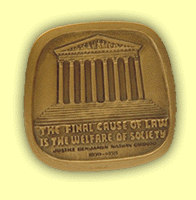
|
| Medal
by Gerta Ries Wiener (1987), Benjamin Cardozo, Supreme Court
Justice. |
Three years
later, Gerta's tenth medal for the Magnes Museum was issued honoring
the developer of the Schick Test for diphtheria - Dr. Bela Schick.
Here again, Gerta enlisted a neighbor - or actually the energetic
daughter of a neighbor - to pose for the medal's reverse. Coincidentally,
in 1924, Gerta Ries (before she was married) was awarded the commission
to create a brochure promoting the Schick Test!
|
|
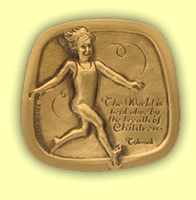
|
| Medal
by Gerta Ries Wiener (1990), Bela Schick, Developed Schick
Test for Diphtheria. |
"When I
got this commission," Gerta told Elaine Leotti, "I took the rough
sketches to the almighty Art Director of Metropolitan Life Insurance
Company, and he raised his arms to heaven and said: 'Miss Ries,
we can't put wooden dolls on our folders - we want real people
- nobody ever made anything like this!'" But this tenacious young
woman stuck to her guns, and "85 million folders were distributed,
their message heeded because of the colorful wooden dolls." "The
almighty Art Director," reported Gerta, "was very happy with the
results."
When she
was preparing the sketches for the Jewish-American Hall of Fame's
tribute to women's rights pioneer Ernestine Rose (issued in 1994
when Gerta was 96), the artist wrote, "I will enjoy doing her. she seemed to have had wit, humor and charm aside from her other
good and rare qualities." I can vouch that Gerta Ries Wiener too
was well endowed with these qualities. Knowing my predilection
for crowds, Gerta humored me by depicting no less than 14 rapt
listeners to Ms. Rose, a lecturer who was known as "Queen of the
Platform."
|
|
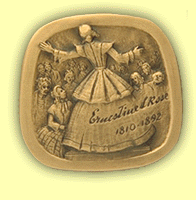
|
| Medal
by Gerta Ries Wiener (1994), Ernestine Rose, Equal rights
pioneer. |
I had hoped
that Gerta could produce an even dozen medals for the Magnes Museum.
And so, she was commissioned to produce a commemorative for avant-garde
writer Gertrude Stein. Gerta produced lovely drawings but, unfortunately,
was not able to complete the sculpting before she suffered from
a series of small strokes. It is hoped that another artist will
be able to complete this project in the future .so that Gerta
Ries Wiener's name will appear one more time on a notable work
of medallic art.
I was delighted
when informed that Gerta Ries Wiener was the 1998 winner of the
American Numismatic Association's Numismatic Art Award for Excellence
in Medallic Sculpture sponsored by the Franklin Mint. It was a
great thrill for me to accept this well-deserved award in her
honor, at the ANA banquet. It was a wonderful gift for Gerta's
100th birthday - that was celebrated on December 9, 1998.
Collectors
wishing to own an example of Gerta Wiener's medallic art, can
get information about availability and prices from the Jewish-American
Hall of Fame Shop.
|